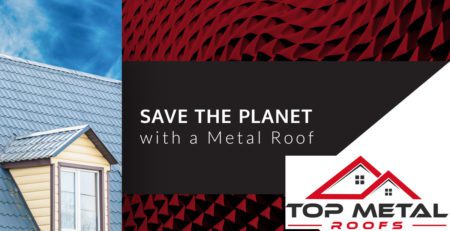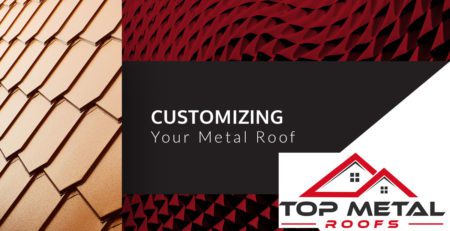How to Install Metal Roofing – Is DIY Roofing Advised?
Currently, a metal roof is the main viable roofing option for the majority of homeowners except for the structures requiring completely flat roof pitches. Current metal roofing designs can imitate almost all traditional asphalt shingle roofs. It is also noteworthy that metal roof price and installation is a critical component of your home construction project due to the substantial money involved. Top Metal Roofs is your top choice when it comes to metal roofing installation services in Ontario, Canada. 
At Top Metal Roofs, we believe your roof installation is of paramount importance. More importantly, we are the best roof installers with a proven history of exceeding our customers’ expectations due to our reliable and affordable services that guarantee you high quality and durability of your home.
Several reasons exist why homeowners would wish to install metal roofing such a reduction in energy cost and increased durability. In most cases, the removal of the old or dilapidated roof and replacing it with metal roof due to its ability to withstand severe weather conditions drive homeowners to consider installing metal roofs. In this article, we provide you with an expert guide for your metal roof installation and why you should consider our professional roof installation instead of doing it yourself.
Process of Metal Roof Installation
There are several different roofing solutions available to you in terms of installing your metal roofing panels, such as steel, aluminum, and tin. Moreover, you can choose from a wide range of colors, styles, and textures when it comes to metal roofs. However, steel metal roofs are the most popular roofing materials due to their superior performance quality, although they are a bit more expensive than others.
If you are considering installing a metal roof, it is important to collect together all the necessary supplies and then install an insulation layer before the new roof. The following are the common steps for installing a metal roof.
Step 1: measurement of the roof area
It is important to measure the entire roof size of your home in square feet to ensure that enough materials are ordered. Though the roof size can be measured from the ground, it gives a more precise measurement if it is done from the roof-top itself. Once the total roof size in the footage has been done, the next thing is adding an extra 10% to take care of any potential waste or human error.
Step 2: ordering the materials
It involves ordering metal panels of your preferred color. Most notably, metal panels are standardized and come in few sizes, but it is possible to get custom-cut metal panels to fit your exact roof size, though this comes with an additional cost. However, any standard home with an inclined roof can be roofed using the standardized sheet sizes already available. Incase metal sheet cutting is needed to accommodate roof-top structures such as a chimney or around vents; power metal shears can be used.
Step 3: Removal of the old roof
At this stage, it is obvious that you are already set to install a metal roof. For those considering replacing an old or dilapidated roof, it will be crucial to get rid of it before a new one is installed. The most appropriate weather to do this is during a sunny and dry day to reduce the possibility of moisture or water damaging your house.
It is recommendable to begin the removal of your old roof from the highest point and concentrate on removing the oldest shingles that are sticking out alongside any vents. Next, any sticking out nails are removed alongside repositioning of any metal gutters to allow proper water flow off the roof. The rest of the roof is then removed, all shingles included. Once this is done, the bare plywood sheathing and roof frame will be visible. Therefore, it is possible to make the necessary repairs to the roof frame before proceeding to the insulation stage.
Step 4: Add insulation
The aim of adding insulation is to reduce the possibilities of any moisture getting to the home structure via the roof. In most cases, adding a layer of roofing felt is enough, but two layers may be added in locations that experience severe weather conditions such as very hot or cold weather. The insulation is secured to the roof frame using roofing nails and a staple gun.
Step 5: Eave flash installation
Eave flashing or simply the edging refers to the steel metal strips used for covering the entire roof perimeter. Essentially, this process involves sealing off the metal roof with the eave flashing, and it should be securely fastened. The one-and-quarter-inch nails are the most suitable for this eave flashing installation. Once this is done, the surface is ready for the installation of metal panels.
Step 6: Installation of metal panels
It is recommendable to start adding metal panels in the area with the most extended square footage area. Essentially, this is the roof area with the longest line between the eave and the peak. It is worth noting that metal panels will hang off the edge. As common roofing practice, this overhang is usually three-quarter of an inch. However, this overhang can be extended depending on the homeowner’s aesthetic look and style. The general approach when installing metal roof panels is ensuring that they are installed at the square to the edge. This makes sure that all the edges are completely covered.
Moreover, metal roofing screws are used for securing the metal panels to the sheathing. 12-inch spacing downwards is recommended for the entire metal panel. More importantly, the screws should be aligned evenly. It is advisable to avoid over-tightening of any exposed fasteners. This is because most of the commonly used fasteners have a rubber grommet for sealing the roof from moisture.
While installing the metal panels, it is important to ensure that edges overlap at least 1 inch with an adjacent panel. This process is continued until the whole roof is covered. The use of a sealant can be considered to give your roof an extra touch. However, a 100% silicon sealant is recommended, where it is applied before laying-down the metal sheet.
Step 7: Addition of the flashing to the roof
In this step, some finishing touches to the roof are done to ensure it is entirely shielded against elements such as hail, snow, or rain. Essentially, the flashing is the metal trim placed over the roof joints where the metal panels merge. It is actually like adding protection layer over the joints, which the most vulnerable sections of the roof.
Step 8: Finish
At this stage, your roofing expert ensures that all the edges have a smooth finish and that al the metal panels are secured to the roof. Once this is done, all the tools and unused supplies are collected, and any waste is disposed of. However, as a homeowner, you may need to retain extra metal panels since you paid for them, and these can be used for future repairs.
Reasons Why Installing Your Roof is Not Recommended
You may be tempted to install your roofing with the assumption that you can search online for everything you need and hence, save money. However, the following are the main reasons why you should not install your roof.
It does not save money
Roofing takes a huge portion of your house construction project. By doing it yourself, you may overlook problematic areas such as decking, thus costing more money for repairs in the long-run. By hiring professional roofers, you avoid incurring continuous repair costs.
Risk of losing your roof warranty
Roofing manufacturers do not guarantee expert roofers have not installed materials. This is because a botched installation may misuse the roofing materials and ultimately result in costly damage. Further, doing your roofing is a gamble and will not guarantee your peace of mind due to the lack of warranty in case of any eventuality. Moreover, it will cost you more by paying for future repairs and maintenance costs of your roof as the roofing manufacturer’s warranty does not cover such costs.
It is dangerous
Roof installation can be a dangerous task. More specifically, roofing your own house presents hazards such as falls due to sloping surfaces, heights, and weather. However, professional roofers have the appropriate equipment and tools needed to work safely under these hazardous conditions. It is also noteworthy that roofing comes with experience, and experienced roof installation services providers have to gain it by doing a similar job over and over again. Therefore, it is obvious that you will not attain the roofing quality of experienced contractors in the roofing industry as they have perfected their skills hundreds of times. In other cases, fatalities have been reported of roofs caves in.
At Top Metal Roofs, we strictly discourage roofing your house due to the risks involved. Moreover, the roof installation process indicated highlighted above is one that requires precision and experience in the roofing industry. Therefore, do not gamble with your life or that of your family by installing your roof. Consider engaging professionals roofing like Top Metal Roofs, and we will perform a professional roof installation for you that assures you of maximum security and durability of your home.
Contact a Top Metal Roofs Contractor
Whether you need a new roof installed or an old one replaced, we top the list of Toronto roofing companies. We have numerous satisfied clients whose success stories testify to our expertise. Our services are unmatched, and we guarantee a roof that will last you a lifetime. Talk to us at 647-470-7161, and we will professionally handle all your metal roofing matters.



